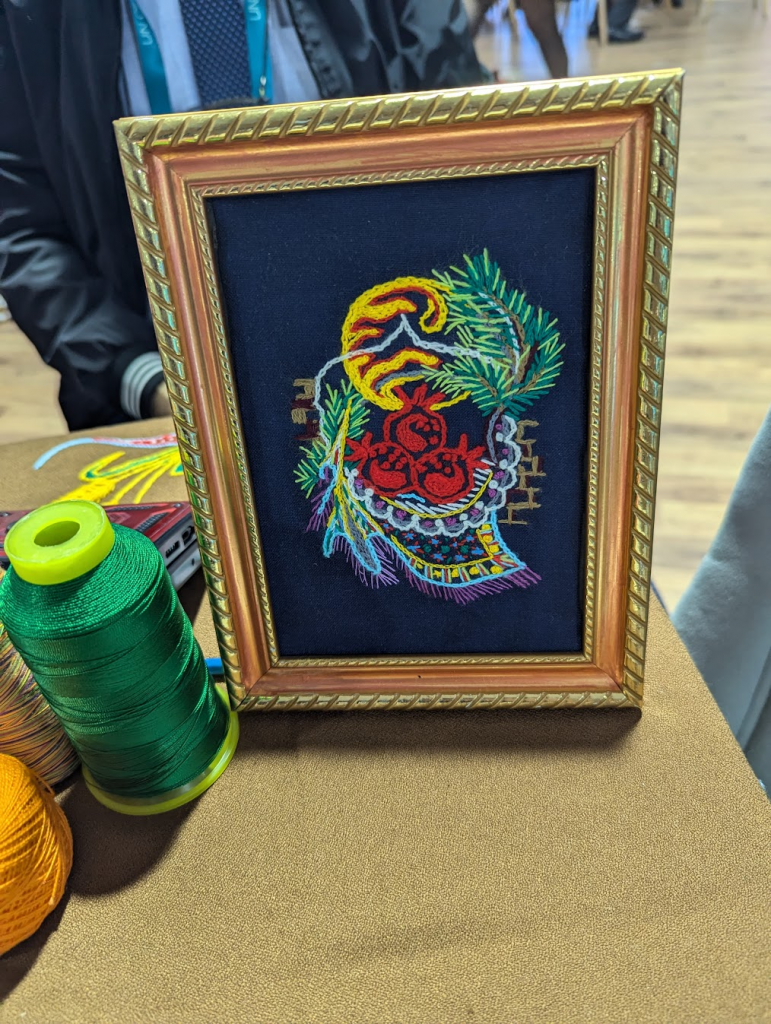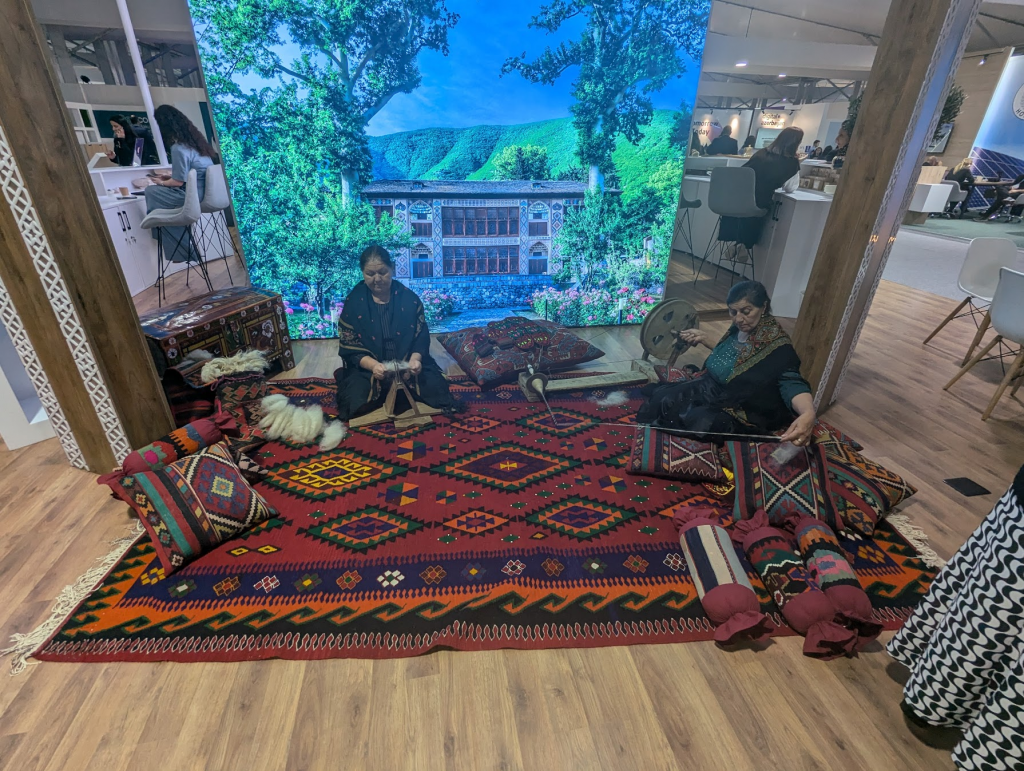
An Azeri Soldier and security camera guard the perimeter to COP29 in Baku, behind which a row of gas-powered turbine generators is visible. (Author)
By Owen Sears (POLS Major/ENGR Minor, Class of 2025, from Philadelphia, PA)
11 November 2024
Any scholar of politics can offer up a definition of the state, and the most common one cites Max Weber as asserting the state as the social body that maintains the monopoly on violence within a territory. This is only the beginning of understanding the nature of modern statehood, and Weber’s thesis (most famously expressed in Politics as a Vocation) allows the scholar to conceive of the state as an entity that can transcend countries and polities.
Enter the petrostate. Countries whose economies rely on carbon fuel exploitation are often referred to as such, especially in a derogatory sense by liberal commentators in the West. Ironically its connotation has become less acute in the modern moment after the painful thrust of the trident: the geopolitical and economic realignment caused by the COVID-19 pandemic, the 2022 Russian invasion of Ukraine, and the 8 October 2023 debut of the Zionist state’s ongoing campaign of its longstanding war against Palestine. In order to understand the modern petrostate it’s important to unpack the impacts of the trident. The pandemic led to record profits for many F500 companies, especially hydrocarbon firms, due to an increased demand for energy. On February 8, 2023 Reuters reported that Big Oil corporations more than doubled their profits in 2022 to $219 billion, going on to pay out a record $110 billion in dividends and stock buybacks to investors. These companies have opted to expand their operations, particularly in the Permian Basin of Texas and Oklahoma, further lowering production costs and increasing revenue. In February 2024 the Guardian reported that the supermajors (Exxon, Shell, BP, Chevron, and France’s Total) have raked in a whopping $281b since the beginning of the Russian invasion. The impact of the demolition of the underwater Nord Stream pipelines should not be overlooked. Far greater than just the effects of releasing a methane bomb into the atmosphere, the bombing of the pipelines (likely executed by Ukrainian divers acting with UK and US support) severed Europe’s connection to Russian gas and paved the way for the United States to become the world’s largest producer of oil and gas. The effects of the 2023-present Gaza campaign are a bit harder to discern from an energy standpoint, but the Guardian gives us a hint in a report from January 2024. “The planet-warming emissions generated during the first two months of the war in Gaza were greater than the annual carbon footprint of more than 20 of the world’s most climate-vulnerable nations,” according to research from the Climate and Community Project. It should be clear that war is terrible for the environment, and military campaigns degrade our shared future by:
- Polluting the land through toxic explosive residue, debris from destroyed structures, and waste left by soldiers
- Polluting the air through vehicle and aircraft emissions, including those of ships that supply forces with fuel and materiel. (Military vehicles emit significantly more carbon and criteria pollutants than civil vehicles due to their use of diesel fuel and limited regulation)
- Requiring carbon-intensive reconstruction and remediation after the end of the war. (It is nearly inconceivable to imagine how Gaza will be rebuilt)
- And other no less important impacts.
Modern warfare requires unholy amounts of fossil fuel. In the case of Palestine, the Zionist military receives its refined military fuels like jet fuel from the American empire, and it now mainly buys the rest of its hydrocarbons from the Republic of Azerbaijan, the country in which I am currently located.
I’m writing this from the lobby of my hotel in Baku, where I am attending COP29, the 2024 Conference of the Parties to the UN Framework Convention on Climate Change. Baku has been built on a vast reservoir of oil so accessible that Marco Polo took note of its black geysers. The first well here was dug a decade before the first in America, and thus Baku can be considered the birthplace of the oil industry. One of Hitler’s goals for his ill-fated Operation Barbarossa, the largest land offensive in human history, was to seize the oil reserves of the Caucasus. His empire ultimately failed in this task, but succeeded in its other goal, which was to slaughter millions of Russians and Slavs to prepare for the German settlement of their lands. Blood and soil, blood and oil; the oil is the lifeblood of this land. The air is hazy and smoky, the three Flame Towers ripple into the sky illuminated in red. The old city itself is beautiful, the architecture and culture eclectic and rich. Everything new here was built by oil.
Azerbaijan is the definition of a petrostate. It is an authoritarian country with Ilham Aliyev as head of state, who took over as president following the death of his father Heydar. The elder Aliyev cut his teeth as a high-ranking officer in the Azeri SSR’s KGB and became a powerful apparatchik within the USSR. His son’s election in 2003 was universally decried as a sham, and a personality cult of the two leaders reigns to this day. I haven’t yet seen any oversized posters bearing their visages above nationalistic quotes or jackbooted troops brutalizing the unhoused, but the atmosphere of authority pervades. CCTV consists of eight swiveling cameras per pole like the spawn of Argus and Hydra. Police in reflective jackets and baseball caps roam the streets, smoking cigarettes and looking bored. At the conference grounds soldiers wearing yellow vests over fatigues stand vigil, planted every fifty meters along the perimeter like camouflage trees. They have batons in their holsters, not firearms, and the people pay them little mind. My interpretation is that repressive state forces are only really necessary if the economy disfavors the common man. In a well-run petrostate the citizen benefits from the strong oil economy and therefore has little gripe with even a completely undemocratic regime.
I describe how I perceive the Azeri state not to castigate the country’s governance structure but to draw parallels between this country and nearly every other. A heavy police presence and extensive surveillance infrastructure is to be expected in a major city. These days NYPD and Empire Shield soldiers conduct searches of subway patrons’ bags, often equipped with military weapons and equipment. In Amsterdam squads of cops encircle and beat antiwar protesters. In Western countries the deployment of chemical agents against demonstrators has become the norm. And of course the United States, as the world’s largest producer of oil and gas, has become the world’s leading petrostate.
However, the key to understanding the petrostate is to recognize that its existence transcends individual states. Governments themselves do not maintain the monopoly on carbon violence wielded by the petrostate: they financially and politically facilitate it, but the machinery of violence lies in the hands of corporations, not nation-states. Only oil and gas companies can produce oil and gas; in order to thwart their destructive plans we must disrupt their economic viability. My conclusion from the Conference is that we as global citizens cannot rely upon state governments, whether national or international, to save us from the impending climate nightmare. Transformative climate action must begin at home, at school, and at work. We must reject the expansion of carbon fuels, petroleum-derived chemical products, and other climate-impacting processes. Now more than ever it is crucial that institutions like Swarthmore make public their commitment to a peaceful future, not just by immediately ceasing their direct and indirect emissions, but primarily by divesting their extensive holdings in the global carbon industry and reinvesting in sustainable community enterprises. Divestment is the single most powerful tool available to those who care about our collective future.
-OS


















